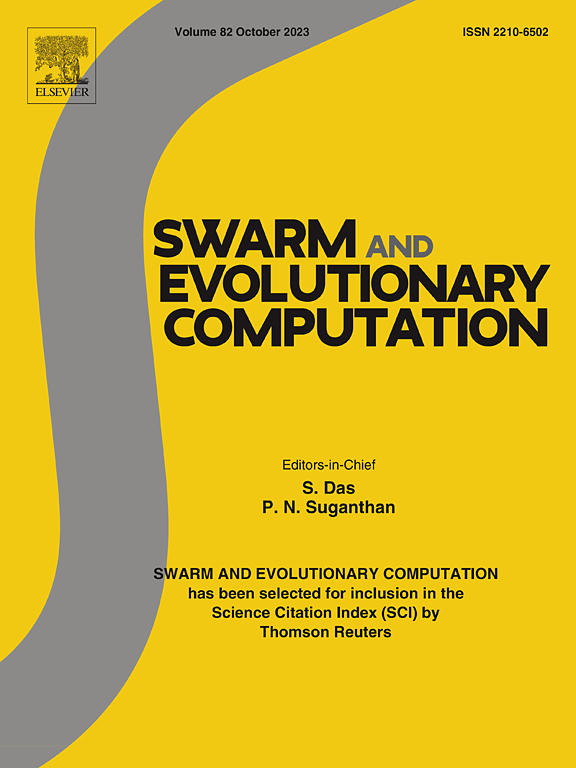An adaptive hybrid MEMD-Transformer-BiGRU model using MPA algorithm for air quality prediction
IF 8.5
1区 计算机科学
Q1 COMPUTER SCIENCE, ARTIFICIAL INTELLIGENCE
引用次数: 0
Abstract
Accurate air quality prediction is usually difficult to achieve because of multiple influencing factors, complex interrelationships and multi-scale processing behaviors. In this study, an adaptive hybrid modelling framework was proposed, which combines Multivariate Empirical Mode Decomposition (MEMD), and Transformer-Bidirectional Gated Recurrent Unit (BiGRU) architectures optimized by the Marine Predators (MPA) Algorithm.
Firstly, a multi-dimensional feature matrix is constructed considering the multiple input variables such as various pollutants, meteorological factors and air quality indices (AQI). And the MEMD method is used for the matrix decomposition and nonlinear coupling features effective extraction, which could reveal deep coupling relationships and spatiotemporal variation patterns from the multi-source heterogeneous data and the Intrinsic Mode Functions (IMFs) could be obtained.
Subsequently, a heterogeneous prediction model combining Transformer and BiGRU networks is designed to capture the overall trends and features of the IMFs. In which, the MPA is utilized for the parameters optimization and an adaptive BiGRU network is employed for the weights dynamical adjusting to emphasize the relative importance of each IMF over time.
Finally, the experiments were given and analyzed with the air quality datasets in Beijing,Tianjin and Shijiazhuang. The results demonstrated that the proposed hybrid model exhibits remarkable efficacy in features extraction, with a root mean square error (RMSE) of 3.1175, mean absolute percentage error (MAPE) of 1.8731 %, and mean absolute error (MAE) of 2.0258, outperforming other comparative models in all comprehensive metrics. Consequently, this hybrid model can effectively improve prediction accuracy and better capture important characteristic information with meteorological factors.
基于MPA算法的MEMD-Transformer-BiGRU混合自适应空气质量预测模型
由于影响空气质量的因素多、相互关系复杂、处理行为多尺度,往往难以实现准确的空气质量预测。本文提出了一种结合多元经验模态分解(MEMD)和海洋捕食者(MPA)算法优化的变压器-双向门控循环单元(BiGRU)结构的自适应混合建模框架。首先,考虑多种污染物、气象因子和空气质量指数(AQI)等多个输入变量,构建多维特征矩阵;利用MEMD方法进行矩阵分解和非线性耦合特征有效提取,揭示了多源异构数据的深层耦合关系和时空变化规律,获得了本征模态函数(IMFs)。随后,设计了一个结合Transformer和BiGRU网络的异构预测模型,以捕捉imf的总体趋势和特征。其中,利用MPA进行参数优化,采用自适应BiGRU网络进行权重动态调整,以强调各IMF随时间的相对重要性。最后,利用北京、天津和石家庄的空气质量数据进行了实验分析。结果表明,混合模型的特征提取效果显著,均方根误差(RMSE)为3.1175,平均绝对百分比误差(MAPE)为1.8731%,平均绝对误差(MAE)为2.0258,在所有综合指标上均优于其他比较模型。因此,该混合模型可以有效地提高预报精度,更好地捕捉具有气象因子的重要特征信息。
本文章由计算机程序翻译,如有差异,请以英文原文为准。
求助全文
约1分钟内获得全文
求助全文
来源期刊

Swarm and Evolutionary Computation
COMPUTER SCIENCE, ARTIFICIAL INTELLIGENCEC-COMPUTER SCIENCE, THEORY & METHODS
CiteScore
16.00
自引率
12.00%
发文量
169
期刊介绍:
Swarm and Evolutionary Computation is a pioneering peer-reviewed journal focused on the latest research and advancements in nature-inspired intelligent computation using swarm and evolutionary algorithms. It covers theoretical, experimental, and practical aspects of these paradigms and their hybrids, promoting interdisciplinary research. The journal prioritizes the publication of high-quality, original articles that push the boundaries of evolutionary computation and swarm intelligence. Additionally, it welcomes survey papers on current topics and novel applications. Topics of interest include but are not limited to: Genetic Algorithms, and Genetic Programming, Evolution Strategies, and Evolutionary Programming, Differential Evolution, Artificial Immune Systems, Particle Swarms, Ant Colony, Bacterial Foraging, Artificial Bees, Fireflies Algorithm, Harmony Search, Artificial Life, Digital Organisms, Estimation of Distribution Algorithms, Stochastic Diffusion Search, Quantum Computing, Nano Computing, Membrane Computing, Human-centric Computing, Hybridization of Algorithms, Memetic Computing, Autonomic Computing, Self-organizing systems, Combinatorial, Discrete, Binary, Constrained, Multi-objective, Multi-modal, Dynamic, and Large-scale Optimization.
 求助内容:
求助内容: 应助结果提醒方式:
应助结果提醒方式:


